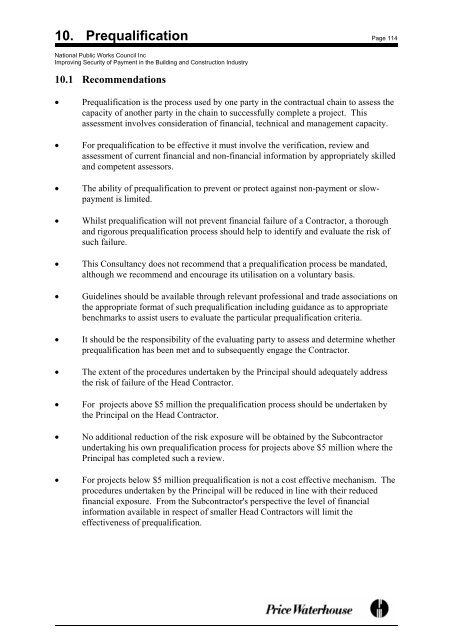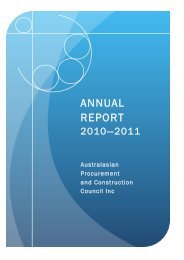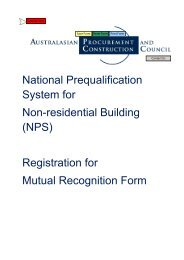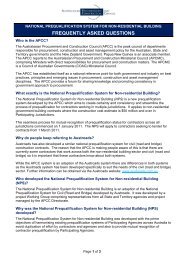Improving Security of Payment Building and Construction Industry
Improving Security of Payment Building and Construction Industry
Improving Security of Payment Building and Construction Industry
- No tags were found...
You also want an ePaper? Increase the reach of your titles
YUMPU automatically turns print PDFs into web optimized ePapers that Google loves.
10. Prequalification Page 114National Public Works Council Inc<strong>Improving</strong> <strong>Security</strong> <strong>of</strong> <strong>Payment</strong> in the <strong>Building</strong> <strong>and</strong> <strong>Construction</strong> <strong>Industry</strong>10.1 Recommendations• Prequalification is the process used by one party in the contractual chain to assess thecapacity <strong>of</strong> another party in the chain to successfully complete a project. Thisassessment involves consideration <strong>of</strong> financial, technical <strong>and</strong> management capacity.• For prequalification to be effective it must involve the verification, review <strong>and</strong>assessment <strong>of</strong> current financial <strong>and</strong> non-financial information by appropriately skilled<strong>and</strong> competent assessors.• The ability <strong>of</strong> prequalification to prevent or protect against non-payment or slowpaymentis limited.• Whilst prequalification will not prevent financial failure <strong>of</strong> a Contractor, a thorough<strong>and</strong> rigorous prequalification process should help to identify <strong>and</strong> evaluate the risk <strong>of</strong>such failure.• This Consultancy does not recommend that a prequalification process be m<strong>and</strong>ated,although we recommend <strong>and</strong> encourage its utilisation on a voluntary basis.• Guidelines should be available through relevant pr<strong>of</strong>essional <strong>and</strong> trade associations onthe appropriate format <strong>of</strong> such prequalification including guidance as to appropriatebenchmarks to assist users to evaluate the particular prequalification criteria.• It should be the responsibility <strong>of</strong> the evaluating party to assess <strong>and</strong> determine whetherprequalification has been met <strong>and</strong> to subsequently engage the Contractor.• The extent <strong>of</strong> the procedures undertaken by the Principal should adequately addressthe risk <strong>of</strong> failure <strong>of</strong> the Head Contractor.• For projects above $5 million the prequalification process should be undertaken bythe Principal on the Head Contractor.• No additional reduction <strong>of</strong> the risk exposure will be obtained by the Subcontractorundertaking his own prequalification process for projects above $5 million where thePrincipal has completed such a review.• For projects below $5 million prequalification is not a cost effective mechanism. Theprocedures undertaken by the Principal will be reduced in line with their reducedfinancial exposure. From the Subcontractor's perspective the level <strong>of</strong> financialinformation available in respect <strong>of</strong> smaller Head Contractors will limit theeffectiveness <strong>of</strong> prequalification.




![NATIONAL COST ADJUSTMENT PROVISION EDITION 2 [NCAP2]](https://img.yumpu.com/48266135/1/184x260/national-cost-adjustment-provision-edition-2-ncap2.jpg?quality=85)











